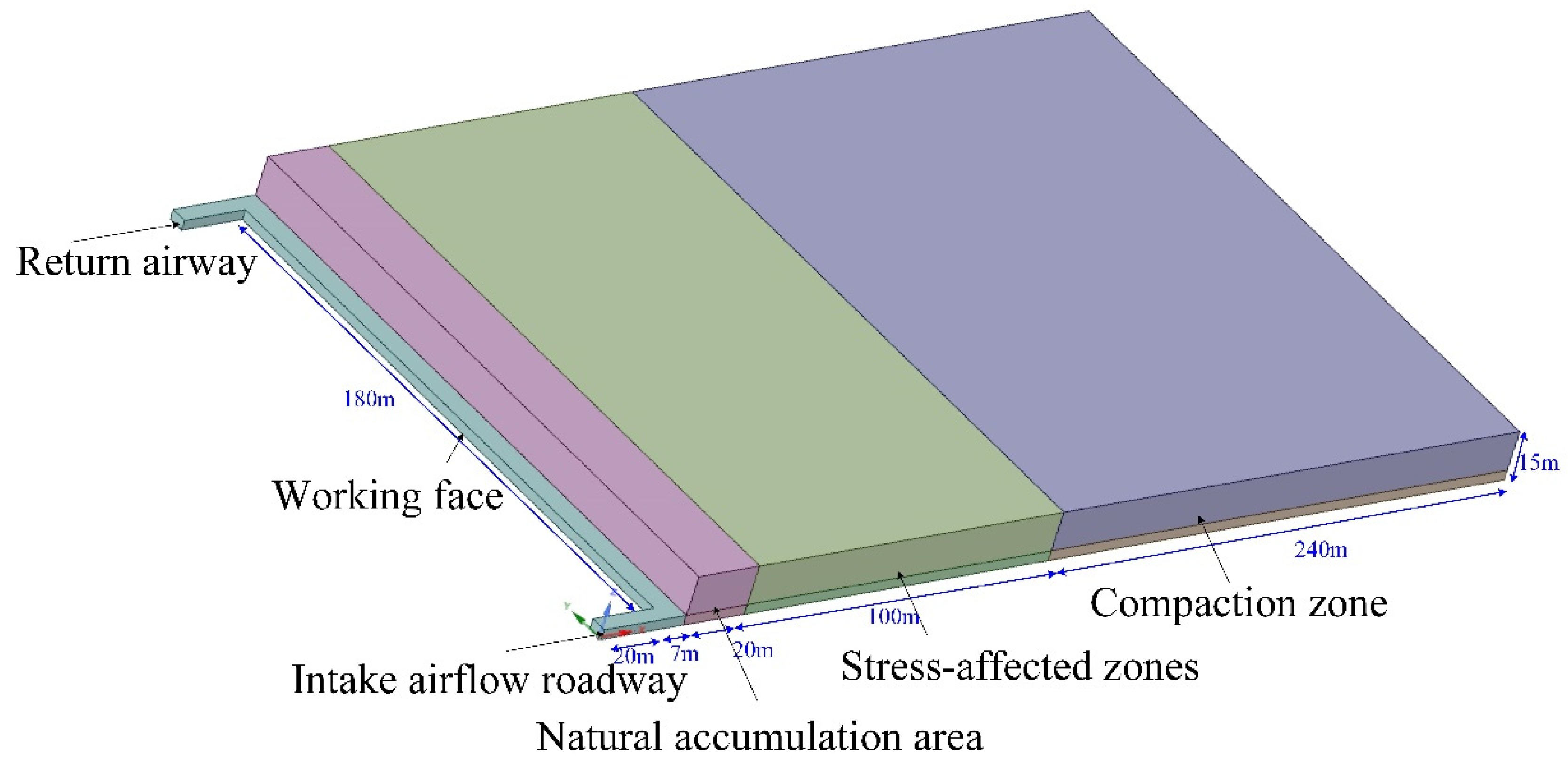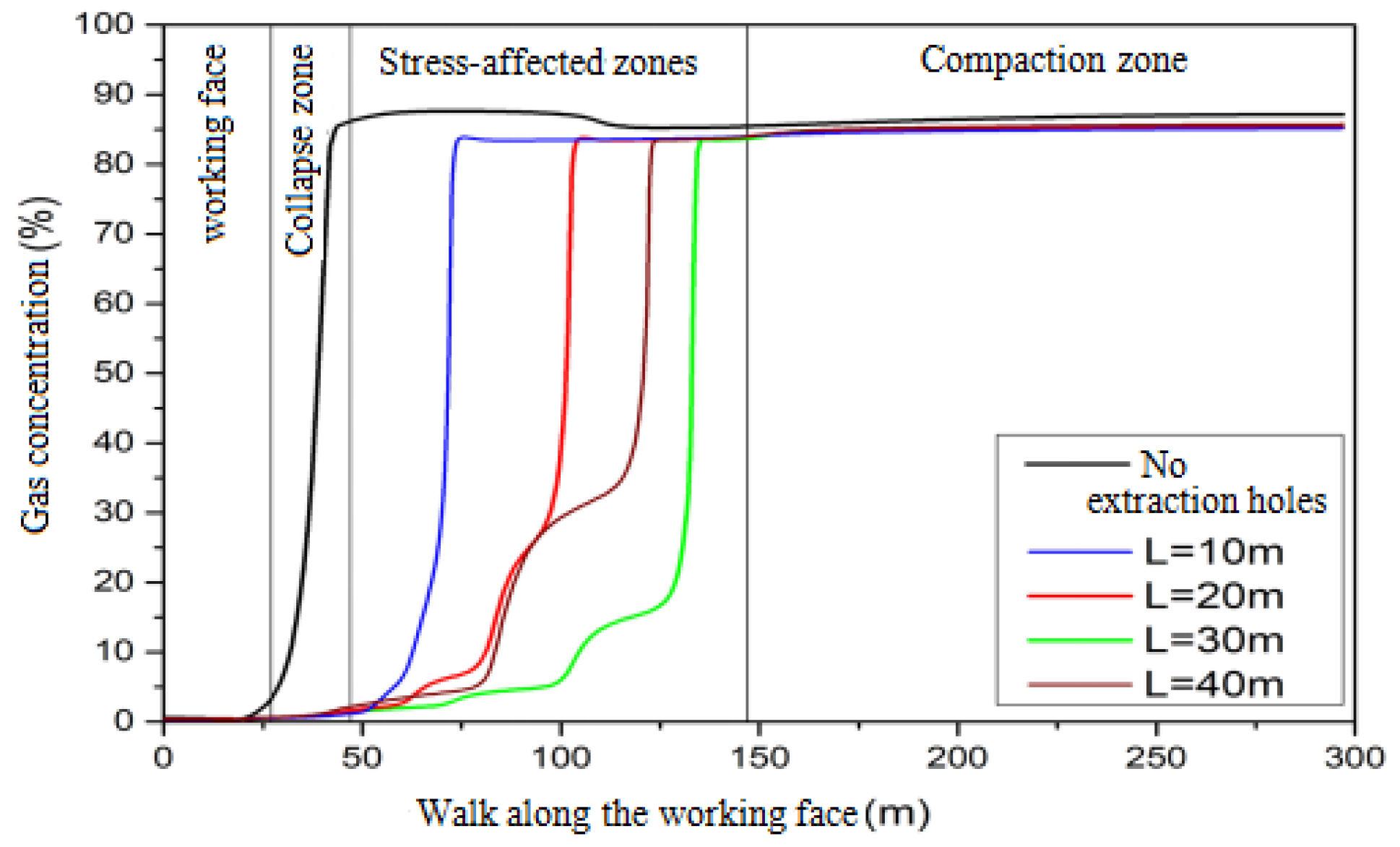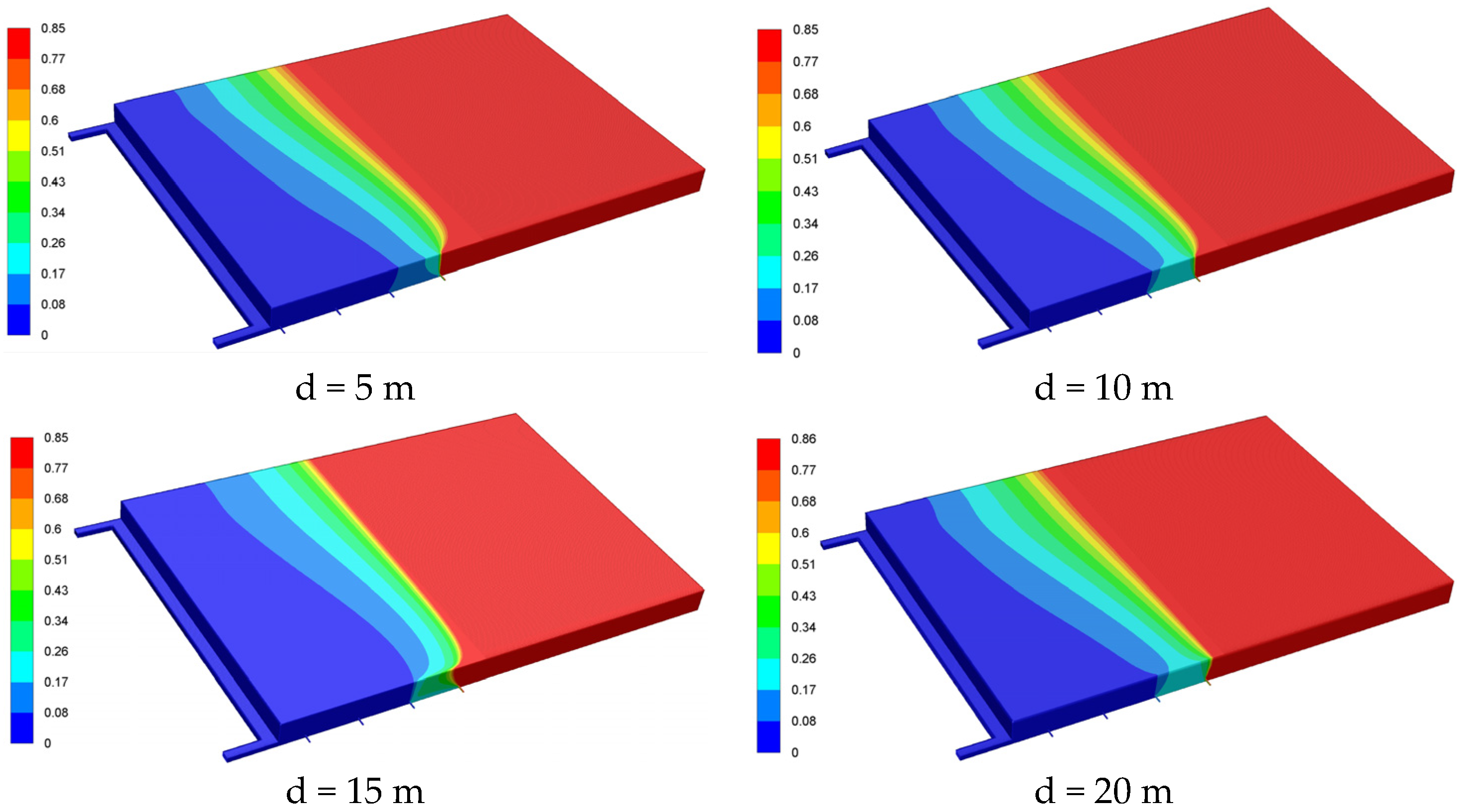Movement Law of Methane Drained by Large-Diameter Borehole Drilling Machine in the Goaf
Abstract
:1. Introduction
2. Overview of the Working Face
3. Numerical Computing Model
3.1. Numerical Computing Model for Methane Flow
3.2. Simulation Scheme
4. Results and Analysis
4.1. With or without Large-Diameter Boreholes
4.2. Large-Diameter Borehole Spacing
4.3. Distance between the Borehole and the Upper Corner
5. Field Test
Scheme Design
6. Conclusions
- (1)
- A reasonable spacing between large-diameter boreholes can effectively change the flow field of the goaf, and the low-pressure area formed at the borehole can manage the methane leakage in the air leakage flow field. Based on the actual geological conditions, physical scale, gas distribution, and other real parameters of the mine, the simulation results show that the optimal spacing of large-diameter boreholes in the goaf is 30 m, and when the boreholes are 15m away from the upper corner, the extraction effect is the best.
- (2)
- The field test shows that when the large-diameter borehole penetrates about 25 m deep into the goaf to reach stress impact area, the methane concentration of the boreholes increases rapidly with the decrease of the porosity (less air leakage), with the maximum being 3.7%. As a result of the drainage superposition effect, when the borehole is drilled 35 m deep into the goaf, the methane concentration of the boreholes slightly decreases.
- (3)
- The methane concentration in the upper corner increases as the distance between the borehole and the upper corner increases. As a result of the drainage superposition effect, the methane concentration in the upper corner changes from 0.32% to 0.51% in a cyclic way.
Funding
Data Availability Statement
Conflicts of Interest
References
- Si, L.L.; Xi, Y.J.; Wei, J.P.; Li, B.; Wang, H.; Yao, B.; Liu, Y. Dissolution characteristics of gas in mine water and its application on gas pressure measurement of water-intrusion coal seam. Fuel 2022, 313, 123004. [Google Scholar] [CrossRef]
- Özgen Karacan, C.; Martín-Fernández, J.A.; Ruppert, L.F.; Olea, R.A. Insights on the characteristics and sources of gas from an underground coal mine using compositional data analysis. Int. J. Coal Geol. 2021, 241, 103767. [Google Scholar] [CrossRef]
- Liu, P.; Fan, J.Y.; Jiang, D.Y.; Li, J. Evaluation of underground coal gas drainage performance: Mine site measurements and parametric sensitivity analysis. Process Saf. Environ. Prot. 2021, 148, 711–723. [Google Scholar] [CrossRef]
- Chen, X.J.; Zhao, S.; Li, L.Y.; Li, X.; Kang, N. Effect of ambient pressure on gas adsorption characteristics of residual coal in abandoned underground coal mines. J. Nat. Gas Sci. Eng. 2021, 90, 103900. [Google Scholar] [CrossRef]
- Song, R.; Liu, J.J.; Yang, C.; Sun, S. Study on the multiphase heat and mass transfer mechanism in the dissociation of methane hydrate in reconstructed real-shape porous sediments. Energy 2022, 254, 124421. [Google Scholar] [CrossRef]
- Gao, K.; Li, S.N.; Liu, Y.J.; Jia, J.; Wang, X. Effect of flexible obstacles on gas explosion characteristic in underground coal mine. Process Saf. Environ. Prot. 2021, 149, 362–369. [Google Scholar] [CrossRef]
- Yu, D.; Ma, Z.; Wang, R. Efficient smart grid load balancing via fog and cloud computing. Math. Probl. Eng. 2022, 2022, 3151249. [Google Scholar] [CrossRef]
- Zhu, Z.; Wu, Y.; Liang, Z. Mining-Induced stress and ground pressure behavior characteristics in mining a thick coal seam with hard roofs. Front. Earth Sci. 2022, 10, 843191. [Google Scholar] [CrossRef]
- Zhang, L.; Huang, M.; Li, M.; Lu, S.; Yuan, X.; Li, J. Experimental study on evolution of fracture network and permeability characteristics of bituminous coal under repeated mining effect. Nat. Resour. Res. 2021, 31, 463–486. [Google Scholar] [CrossRef]
- Liu, Y.; Zhang, Z.; Liu, X.; Wang, L.; Xia, X. Ore image classification based on small deep learning model: Evaluation and optimization of model depth, model structure and data size. Miner. Eng. 2021, 172, 107020. [Google Scholar] [CrossRef]
- Zhang, G.; Zhang, Z.; Sun, M.; Yu, Y.; Wang, J.; Cai, S. The influence of the temperature on the dynamic behaviors of magnetorheological gel. Adv. Eng. Mater. 2022, 2101680. [Google Scholar] [CrossRef]
- Dong, J.; Deng, R.; Quanying, Z.; Cai, J.; Ding, Y.; Li, M. Research on recognition of gas saturation in sandstone reservoir based on capture mode. Appl. Radiat. Isot. 2021, 178, 109939. [Google Scholar] [CrossRef]
- Lei, B.W.; He, B.B.; Zhao, Z.D.; Xu, G.; Wu, B. A method for identifying the fire status through ventilation systems using tracer gas for improved rescue effectiveness in roadway drivage of coal mines. Process Saf. Environ. Prot. 2021, 151, 151–157. [Google Scholar] [CrossRef]
- Wang, K.; Zhang, X.; Wang, L.; Li, L.; Zhang, M.; Zhou, A. Experimental study on propagation law of shock wave and airflow induced by coal and gas outburst in mine ventilation network. Process Saf. Environ. Prot. 2021, 151, 299–310. [Google Scholar] [CrossRef]
- Song, R.; Sun, S.Y.; Liu, J.J.; Feng, X. Numerical modeling on hydrate formation and evaluating the influencing factors of its heterogeneity in core-scale sandy sediment. J. Nat. Gas Sci. Eng. 2021, 90, 103945. [Google Scholar] [CrossRef]
- Yu, D.; Wu, J.; Wang, W.; Gu, B. Optimal performance of hybrid energy system in the presence of electrical and heat storage systems under uncertainties using stochastic p-robust optimization technique. Sustain. Cities Soc. 2022, 83, 103935. [Google Scholar] [CrossRef]
- Liu, Y.; Zhang, Z.; Liu, X.; Wang, L.; Xia, X. Efficient image segmentation based on deep learning for mineral image classification. Adv. Powder Technol. 2021, 32, 3885–3903. [Google Scholar] [CrossRef]
- Zhang, L.; Huang, M.; Xue, J.; Li, M.; Li, J. Repetitive mining stress and pore pressure effects on permeability and pore pressure sensitivity of bituminous coal. Nat. Resour. Res. 2021, 30, 4457–4476. [Google Scholar] [CrossRef]
- Fan, C.; Li, H.; Qin, Q.; He, S.; Zhong, C. Geological conditions and exploration potential of shale gas reservoir in Wufeng and Longmaxi Formation of southeastern Sichuan Basin, China. J. Pet. Sci. Eng. 2020, 191, 107138. [Google Scholar] [CrossRef]
- Hu, S.; Wu, H.; Liang, X.; Xiao, C.; Zhao, Q.; Cao, Y.; Han, X. A preliminary study on the eco-environmental geological issue of in-situ oil shale mining by a physical model. Chemosphere 2020, 287, 131987. [Google Scholar] [CrossRef]
- Gao, H.; Yang, H.W. Super large diameter borehole gob gas extraction technology. Coal Sci. Technol. 2019, 47, 77–81. [Google Scholar]
- Jia, J.Z.; Guo, J. Application of large diameter extraction drilling in goaf gas drainage. J. Liaoning Technol. Univ. Nat. Sci. 2020, 39, 1–5. [Google Scholar]
- Shao, G.A.; Zou, Y.M. Prevention technology of residual coal spontaneous combustion in goaf un-der the condition of large diameter borehole extraction. Saf. Coal Mines 2020, 51, 74–77. [Google Scholar]
- Yang, Q.Y.; Luo, H.G.; Shi, B.M.; Zhang, L.L.; Zhang, H.Z. Numerical study on drainage parameters optimization of buried pipe in goaf based on COMSOL. J. Saf. Sci. Technol. 2019, 15, 90–95. [Google Scholar]
- Shi, G.Q.; Wang, G.Q.; Ding, P.X.; Wang, Y.M. Model and simulation analysis of fire development and gas flowing influenced by fire zone sealing in coal mine. Process Saf. Environ. Prot. 2021, 149, 631–642. [Google Scholar] [CrossRef]
- Zhang, L.; Li, J.; Xue, J.; Zhang, C.; Fang, X. Experimental studies on the changing characteristics of the gas flow capacity on bituminous coal in CO2-ECBM and N2-ECBM. Fuel 2021, 291, 120115. [Google Scholar] [CrossRef]
- Shen, X.; Hong, Y.; Zhang, K.; Hao, Z. Refining a distributed linear reservoir routing method to improve performance of the crest model. J. Hydrol. Eng. 2017, 22, 4016061. [Google Scholar] [CrossRef]
- Li, J.B.; Cheng, F.; Lin, G.; Wu, C.L. Improved hybrid method for the generation of ground motions compatible with the multi-damping design spectra. J. Earthq. Eng. 2022, 1–27. [Google Scholar] [CrossRef]
- Zhang, G.; Chen, J.; Zhang, Z.; Sun, M.; Yu, Y.; Wang, J.; Cai, S. Analysis of magnetorheological clutch with double cup-shaped gap excited by Halbach array based on finite element method and experiment. Smart Mater. Struct. 2022, 31, 075008. [Google Scholar] [CrossRef]










| Area | Working Face | Natural Accumulation Area | Stress Impact Area | Compaction Area |
|---|---|---|---|---|
| Porosity | - | 0.36% | 0.24% | 0.09% |
| Source item | 2.78 × 10−5 kg/m3·s | 6.66 × 10−75 kg/m3·s | 5.78 × 10−75 kg/m3·s | 4.88 × 10−75 kg/m3·s |
Publisher’s Note: MDPI stays neutral with regard to jurisdictional claims in published maps and institutional affiliations. |
© 2022 by the author. Licensee MDPI, Basel, Switzerland. This article is an open access article distributed under the terms and conditions of the Creative Commons Attribution (CC BY) license (https://creativecommons.org/licenses/by/4.0/).
Share and Cite
Lei, Y. Movement Law of Methane Drained by Large-Diameter Borehole Drilling Machine in the Goaf. Processes 2022, 10, 1669. https://doi.org/10.3390/pr10091669
Lei Y. Movement Law of Methane Drained by Large-Diameter Borehole Drilling Machine in the Goaf. Processes. 2022; 10(9):1669. https://doi.org/10.3390/pr10091669
Chicago/Turabian StyleLei, Yun. 2022. "Movement Law of Methane Drained by Large-Diameter Borehole Drilling Machine in the Goaf" Processes 10, no. 9: 1669. https://doi.org/10.3390/pr10091669
APA StyleLei, Y. (2022). Movement Law of Methane Drained by Large-Diameter Borehole Drilling Machine in the Goaf. Processes, 10(9), 1669. https://doi.org/10.3390/pr10091669





